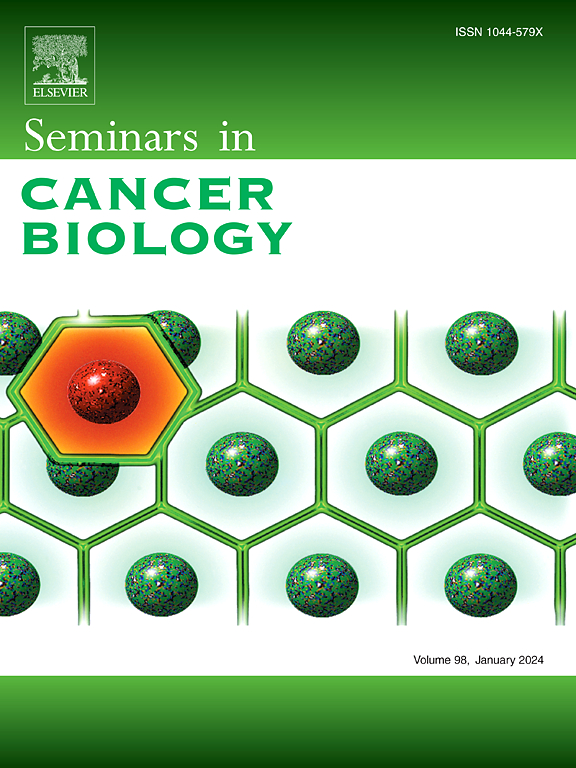Convergent evolution of senescent fibroblasts in fibrosis and cancer with aging
IF 12.1
1区 医学
Q1 ONCOLOGY
引用次数: 0
Abstract
Aging is associated with stereotyped changes in the tissue microenvironment that increase susceptibility to diseases of the elderly, including organ fibrosis and cancer. From a tissue perspective, fibrosis and cancer can both be viewed as non-healing wounds with pathogenic activation of tissue repair pathways in the stroma. If fibrosis and cancer represent an example of the convergent evolution of maladaptive stromal responses in distinct pathologies, what are the analogous cell types that might emerge in both diseases that share similarities in identity and function? In this review, we explore how senescent fibroblasts form a nexus that connects the aging organ with both fibrosis and cancer. The advent of single cell sequencing, coupled with improved detection of cell types with senescent traits in vivo, have allowed us to identify senescent fibroblasts with similar identities in both fibrosis and cancer that share pro-fibrotic programs. In addition to their ability to reorganize the extracellular matrix in diseased states, these pro-fibrotic senescent fibroblasts can also promote epithelial reprogramming and immune rewiring, which drive disease progression in fibrosis and cancer. Finally, the identification of common pathogenic cell types in fibrosis and cancer also presents a therapeutic opportunity to target both diseases with a shared approach.
纤维化和癌症中的衰老成纤维细胞随衰老而趋同进化。
衰老与组织微环境的定型变化有关,这种变化增加了对器官纤维化和癌症等老年疾病的易感性。从组织的角度来看,纤维化和癌症都可以被视为基质中组织修复途径的致病性激活导致的伤口不愈合。如果说纤维化和癌症是不同病理中基质不良反应趋同进化的一个例子,那么这两种疾病中可能出现的在特征和功能上具有相似性的细胞类型又是什么呢?在这篇综述中,我们将探讨衰老成纤维细胞如何形成连接衰老器官与纤维化和癌症的纽带。单细胞测序技术的出现,加上对体内具有衰老特征的细胞类型检测的改进,使我们能够识别出在纤维化和癌症中具有相似特征的衰老成纤维细胞,它们共享促纤维化程序。除了能在患病状态下重组细胞外基质外,这些促纤维化的衰老成纤维细胞还能促进上皮重编程和免疫重接线,从而推动纤维化和癌症的疾病进展。最后,纤维化和癌症中共同致病细胞类型的确定也提供了一个治疗机会,可以用共同的方法来治疗这两种疾病。
本文章由计算机程序翻译,如有差异,请以英文原文为准。
求助全文
约1分钟内获得全文
求助全文
来源期刊

Seminars in cancer biology
医学-肿瘤学
CiteScore
26.80
自引率
4.10%
发文量
347
审稿时长
15.1 weeks
期刊介绍:
Seminars in Cancer Biology (YSCBI) is a specialized review journal that focuses on the field of molecular oncology. Its primary objective is to keep scientists up-to-date with the latest developments in this field.
The journal adopts a thematic approach, dedicating each issue to an important topic of interest to cancer biologists. These topics cover a range of research areas, including the underlying genetic and molecular causes of cellular transformation and cancer, as well as the molecular basis of potential therapies.
To ensure the highest quality and expertise, every issue is supervised by a guest editor or editors who are internationally recognized experts in the respective field. Each issue features approximately eight to twelve authoritative invited reviews that cover various aspects of the chosen subject area.
The ultimate goal of each issue of YSCBI is to offer a cohesive, easily comprehensible, and engaging overview of the selected topic. The journal strives to provide scientists with a coordinated and lively examination of the latest developments in the field of molecular oncology.
 求助内容:
求助内容: 应助结果提醒方式:
应助结果提醒方式:


